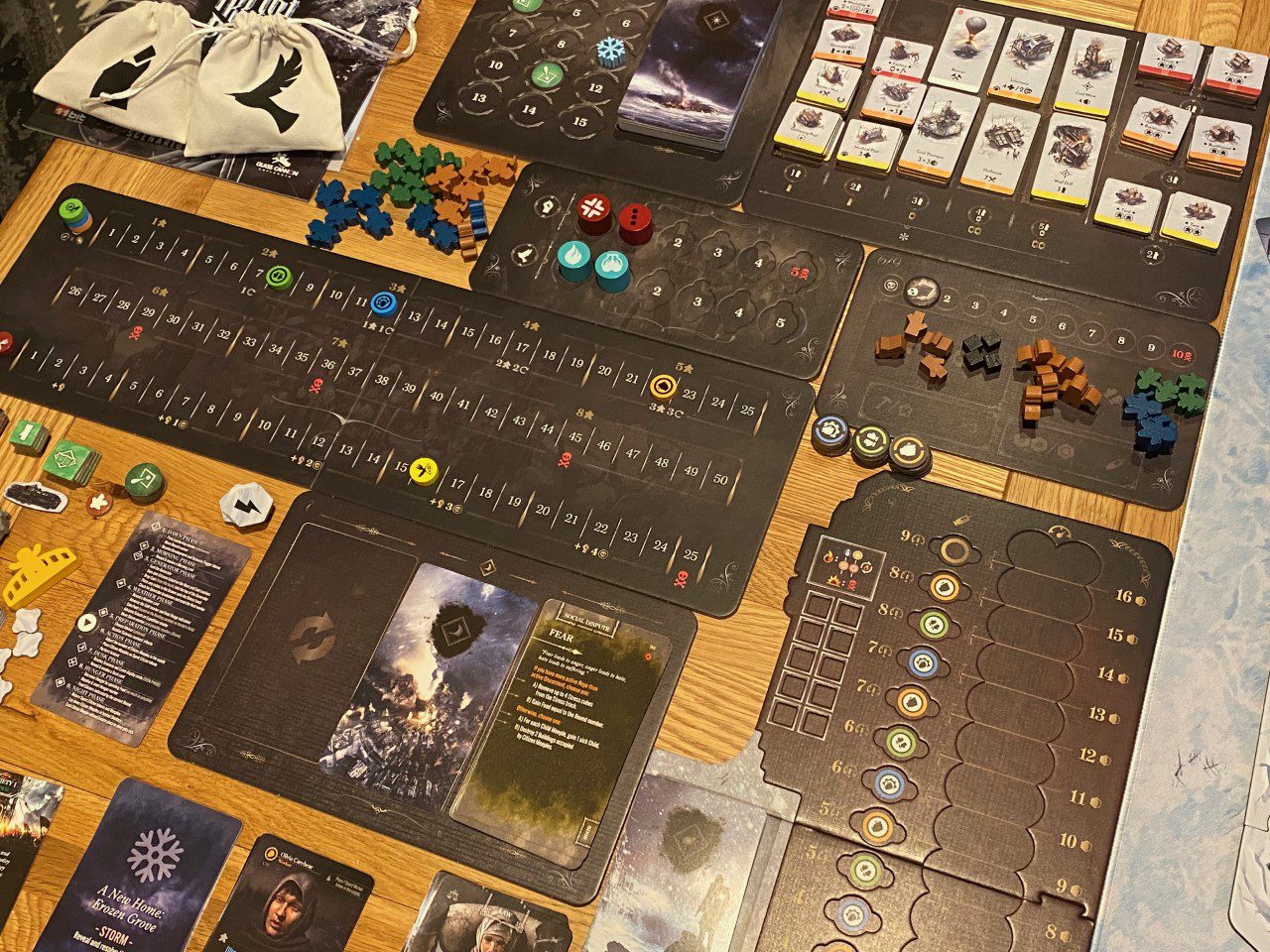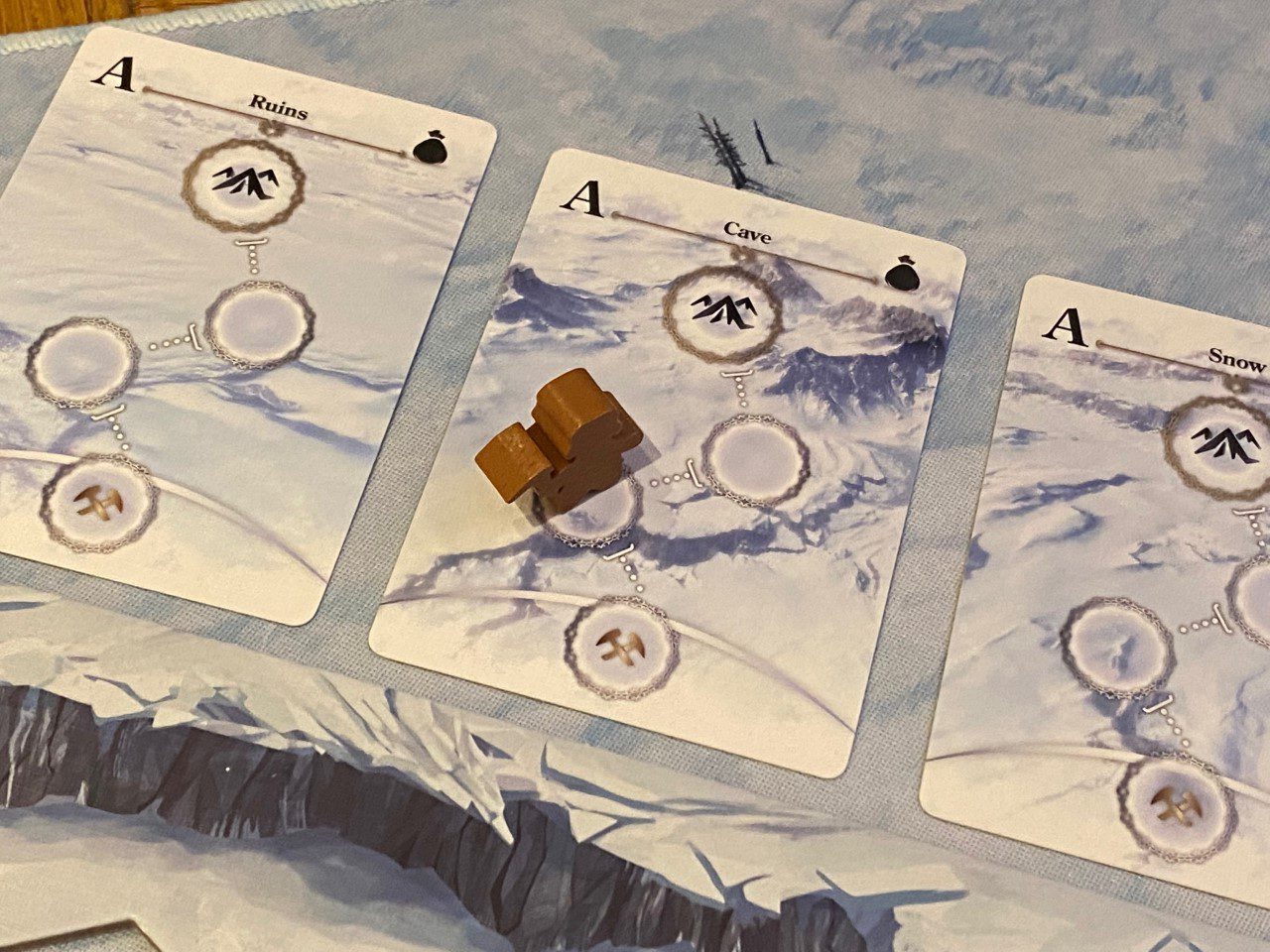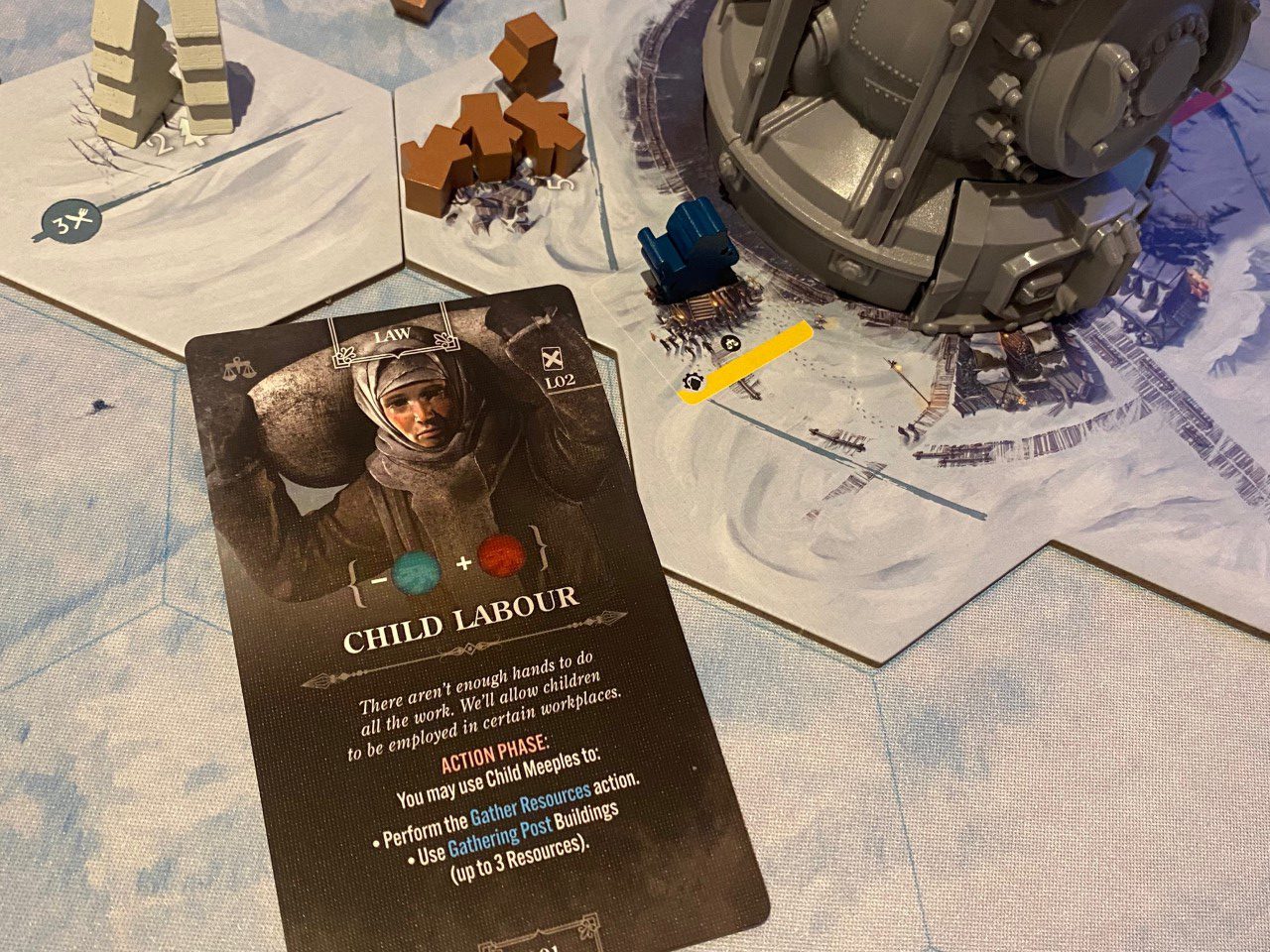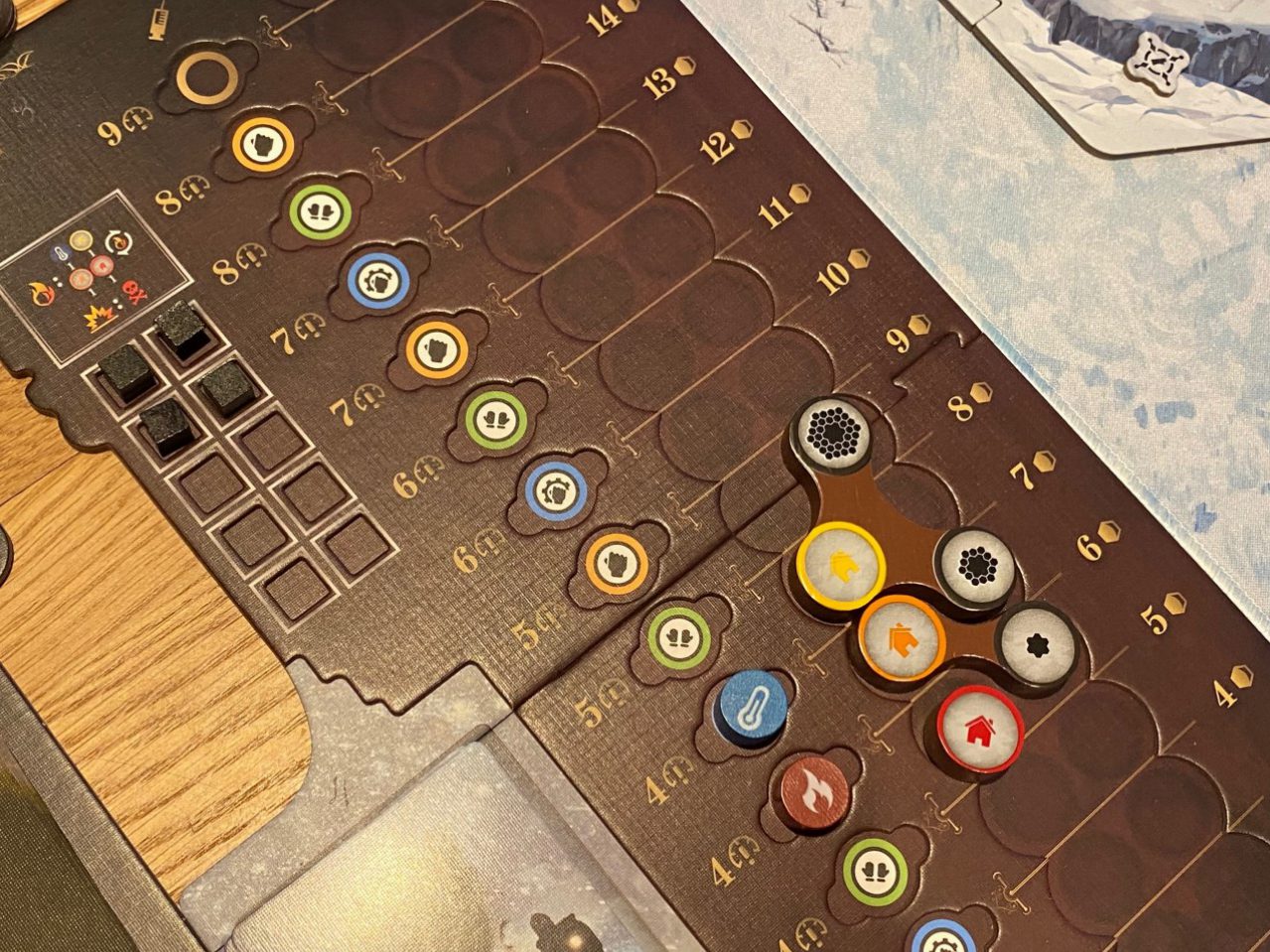Frostpunk: The Board Game is an incredible replication of the videogame
There have been some fantastic board game adaptations of video games over the years, with Devil May Cry and Dark Souls from Steamforged Games being just a couple of examples. In both these examples, however, only a slice of the videogame experience is captured — albeit perhaps the tastiest morsel. Frostpunk — which is a deep, complex strategy game — is a completely different prospect, and one that I am amazed to say has been captured almost flawlessly by the aptly named Frostpunk: The Board Game.
There are two ways for me to tackle this review — the first would have been for me to assume that you know Frostpunk in detail, whilst the second — which is the one I am going to go for — is to work on the basis that you don’t know much about it at all. That said, when I reference a specific thing in the videogame, I probably won’t go into elaborate detail, since the focus here is very much on Frostpunk: The Board Game.

In both the video game and Frostpunk: The Board Game, the player(s) will take responsibility for leading a small group of survivors in an alternative, broadly steampunk-inspired post-apocalyptic world, broadly around the end of the nineteenth century. In this reality, the world is experiencing an ice age like never before, and life as people knew it is over — instead, communities must now cluster around huge generators to keep warm, whilst carving a meagre existence from the snow.
In Frostpunk: The Board Game, the board is set up as a hexagonal space bordered (physically) by cardboard pieces. The location of the generator is usually central (at least in the basic scenario) to this hexagon, and the setup includes the random placement of a few resources on each edge of the board, as well as the placement of some smaller hexagon tiles which fit between the generator tile and the edge of the map (which is stylised to represent a large crater).

Frostpunk: The Board Game also requires the players to set up an incredible amount of supporting boards, which must be managed during the game. One of these deals with the current round (including any specific events or research actions), another deals with the number, health and hunger of your citizens, one is just a template to store buildings, one a general supply, another tracks both your hope and discontent and perhaps the most important one tracks your heat level and the status of the generator.
Unbelievably there are still a couple of other stacks of cards and tracks to manage during set up (dusk cards and weather cards for example) but I’ve ran out of ways to say “and one more board for this…” so I’ll just stop here and say that there is an overwhelming amount of stuff to take into account during your first play, and this does make Frostpunk: The Board Game quite daunting. On a positive note, the presence of these tracks (for anyone who knows Frostpunk in videogame form) denotes just how faithful this game is to its source material — and the fact that there are boards to prompt the players means that missing one or more aspects of setup is unlikely.

This idea of theme delivered through labour is consistent in most aspects of Frostpunk: The Board Game — including the core concept itself. This is a world in which toil is fundamental to survival, and whilst I have often felt that board games which use numerous tracks to maintain the game state are less desirable than those which are cleaner and more straightforward, the systems in Frostpunk: The Board Game just work. Every player receives a specific card detailing their role in society (Social Advisor, for example) and a minor bonus that confers. They also receive a hand of citizen cards and an A4-sized sheet of responsibilities associated with their role.
These sheets are mostly focused on who manages which tracks (to split up the workload) but you should always know that whether you are playing with one person or four, you’ll still need to manage every track. For me, this makes Frostpunk: The Board Game an appealing solo game (because a player can learn everything in their own time) or as a game played repeatedly with the same group (so that everyone knows their role in society).

There’s more good news here in that whilst there are a lot of them, most of these tracks and things to manage are well laid out and quite logical. For example, you use coal to power the generator and one coal equals one bump on the generator output track — which increases the heat. The heat level links to a few nifty tokens that measure warmth in buildings of three different insulation levels (yellow, orange and red) and three distances from the generator (inner, middle and outer).
With this concept of heat in mind, if a player is then assessing their action, they will look at the available worker, engineer and child meeples, decide what they want to do, and decide if the task will be heated or cold. If the heat level exceeds the current position of the location where the task is (based on either building insulation level or range from the generator) then everything is fine, but if the job being done is in a cold location, that worker will become sick (which is then reflected on the sickness track). If a meeple ever gets gravely ill or dies for some other reason, this death will also be traced (with the population dropping by one and the death track increasing by one) and so it goes on. My point here is — the tracks may be numerous, but they are useful and completely logical in context with what you’re doing in the game.

So what about Frostpunk: The Board Game might compel you to do something that makes people sick? What are you actually doing? These are both good questions — and of course, they are dependent on what scenario you are playing. In the first scenario, for example, all you know is that you need to set up a beacon in the hopes of contacting other survivors… What happens once you do (or if you don’t) will be a mystery. What you do know is that you must complete this task before the start of round four — or else the consequence is likely to be negative.
There are at least six ways to lose a game of Frostpunk: The Board Game and generally you’ll only win after completing multiple steps in an objective-driven narrative. A loss will occur if your people either gain too much discontent or lose all hope, or if too many people die, or if the generator explodes — all of which can happen quite easily. You’ll also lose if you fail certain objective conditions and almost certainly because of a number of other things that I might not even have seen.

Playing Frostpunk: The Board Game is to flirt with these risks almost constantly. If your generator is sufficiently heating your community, then it is under strain and therefore more likely to explode, plus you’ll need to gather more coal. If you’re out gathering coal, you might not be collecting enough food, or building enough shelters… If you’re not building shelters, then people will get sick at night, if people are sick, then you’ll need to build infirmaries and spend actions to heal people — and so it goes on. All of these things detract from objectives like building a beacon — which in itself is a resource and action-intensive process.
Now, despite all of this stuff that has to be managed in Frostpunk: The Board Game, that’s not really what the game is about. This is a game of consequences — of moral decisions and finely balanced cause and effect. The core resource management and sheer labour that I’ve already described has to be done, but it is affected massively each in-game day by unknown factors that are dealt out daily via linked decks of cards that ask big, big questions.

Each morning, a card will be drawn which generally demands a decision. A band of weary travellers arrives — will you welcome them (adding sick and hungry mouths to your settlement — albeit ones that can work) or will you send them away? Either way, there may be an immediate consequence (in this case, you add people (and sick people) to your tracks) but there will also be a reaction later — which is handled by shuffling a different card into another deck which will be revealed in a later phase of the game. These cards, along with a “basic consequences” card and a “Social Dilemma” will always be waiting for you — and you need to think about what might be drawn and how it will affect you.
Moral choices exist both here and in almost every other part of Frostpunk: The Board Game, with another example being through the laws that you can enact. Just as in the video game, players are able to implement ideas such as Child Labour, or Gambling. Each law has an opposing law, and if you implement a law from one side of a particular debate, the other will be removed from the game. Either way, when a law is chosen, something will happen — often both right away and potentially something else in the future.

To use a direct example that you’ll see very early in the game, I’ll discuss Child Labour here (vs Child Shelter, which is the opposing law). If Child Labour is enacted, all child meeples (which are otherwise pretty useless) can be used to do basic gathering tasks — which usually provides the players with an extra one to three actions per round. On the downside, hope will immediately fall (because the people don’t want to see their kids put to work) and a card will be added to the dusk deck which might have further consequences — maybe a child dies in a work-related accident… But that said, two to three extra actions per round is massive when you’re in a fight for survival.
When I played Frostpunk in videogame form, I found these dilemmas worthy of consideration even though I was playing alone. Often the worst possible choices from a moral perspective gave the best short-term or immediate benefits, and sometimes you just had to make them to stay in the game. In Frostpunk: The Board Game the solo aspect feels very similar, but when you play with a number of friends, the offboard discussion takes a big part of the stage — some people will see the benefit of sending children to work, others will want to enact Child Shelter. (Child Shelter doesn’t provide the actions, but it does make children easier to maintain… And maybe it will pay off later?)

As I start to work towards summarising my thoughts on Frostpunk: The Board Game, I simply have to say that whether you love it or hate it, this is a game that offers a fairly unique experience. It features fully realised mechanics for worker placement, city building, narrative exposition, negotiation and survival — and it does so in a way that is totally comprehensive. No aspect of the video game is left out, and nothing implemented here has been done so without what feels like rigorous and comprehensive playtesting. There are still things that I haven’t mentioned — such as scouting — that again are damn near perfect in terms of how they replicate the videogame, and also how they work as a set of interlocking board game mechanics.
Despite this review being broadly complimentary (because to be clear, I have massive respect for what Frostpunk: The Board Game does, how it does it, how it looks and how it feels) I will say that this isn’t a game for everyone. Frostpunk: The Board Game is so difficult at times that you could lose in less than two complete rounds of play and you almost certainly will lose in less than four rounds of play at least once or twice. People don’t like losing, and other cooperative games like Pandemic (just to pick one at random) tend to make losses feel a lot more like a close-run thing. Frostpunk: The Board Game does not. It simply presents you with all the facts, and sometimes you run out of ways to deal with them — and it will be your own fault even if you can’t see how.

So, if you like solo games, or if you enjoy cooperative games that have a lasting challenge (and Frostpunk: The Board Game has many ways to set up different scenarios) then Frostpunk: The Board Game should be very close to the top of your list. This might be the most complete and comprehensive cooperative game that I’ve played, and for me, it’s probably also the best — by quite a country mile. That said, I like the video game and I am good at it, and a lot of what I know from that experience has carried over for me. Despite the fact that I like Frostpunk: The Board Game a lot, I must also say that it is a beast of a thing to set up and learn, and especially to teach to new players.
You can purchase Frostpunk: The Board Game on Amazon.
Love both video games and board games? Here’s our list of some fantastic crossover games.
Comments are closed.